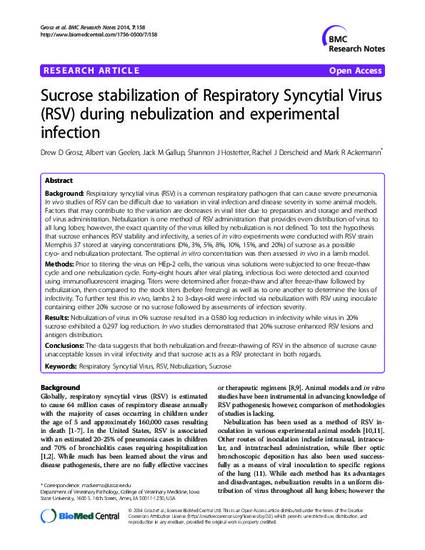
Article
Sucrose stabilization of Respiratory Syncytial Virus (RSV) during nebulization and experimental infection
BMC Research Notes
Document Type
Article
Disciplines
Publication Version
Published Version
Publication Date
3-18-2014
DOI
10.1186/1756-0500-7-158
Abstract
Background Respiratory syncytial virus (RSV) is a common respiratory pathogen that can cause severe pneumonia. In vivo studies of RSV can be difficult due to variation in viral infection and disease severity in some animal models. Factors that may contribute to the variation are decreases in viral titer due to preparation and storage and method of virus administration. Nebulization is one method of RSV administration that provides even distribution of virus to all lung lobes; however, the exact quantity of the virus killed by nebulization is not defined. To test the hypothesis that sucrose enhances RSV stability and infectivity, a series of in vitro experiments were conducted with RSV strain Memphis 37 stored at varying concentrations (0%, 3%, 5%, 8%, 10%, 15%, and 20%) of sucrose as a possible cryo- and nebulization protectant. The optimal in vitro concentration was then assessed in vivo in a lamb model.
Methods Prior to titering the virus on HEp-2 cells, the various virus solutions were subjected to one freeze-thaw cycle and one nebulization cycle. Forty-eight hours after viral plating, infectious foci were detected and counted using immunofluorescent imaging. Titers were determined after freeze-thaw and after freeze-thaw followed by nebulization, then compared to the stock titers (before freezing) as well as to one another to determine the loss of infectivity. To further test this in vivo, lambs 2 to 3-days-old were infected via nebulization with RSV using inoculate containing either 20% sucrose or no sucrose followed by assessments of infection severity.
Results Nebulization of virus in 0% sucrose resulted in a 0.580 log reduction in infectivity while virus in 20% sucrose exhibited a 0.297 log reduction. In vivo studies demonstrated that 20% sucrose enhanced RSV lesions and antigen distribution.
Conclusions The data suggests that both nebulization and freeze-thawing of RSV in the absence of sucrose cause unacceptable losses in viral infectivity and that sucrose acts as a RSV protectant in both regards.
Rights
This is an Open Access article distributed under the terms of the Creative Commons Attribution License (http://creativecommons.org/licenses/by/2.0), which permits unrestricted use, distribution, and reproduction in any medium, provided the original work is properly credited.
Copyright Owner
Grosz, et al
Copyright Date
2014
Language
en
File Format
application/pdf
Citation Information
Drew D. Grosz, Albert G. van Geelen, Jack M. Gallup, Shannon J. Hostetter, et al.. "Sucrose stabilization of Respiratory Syncytial Virus (RSV) during nebulization and experimental infection" BMC Research Notes Vol. 7 (2014) p. 158 Available at: http://works.bepress.com/jack_gallup/16/

This article is from BMC Research Notes 7 (2014): 158, doi:10.1186/1756-0500-7-158. Posted with permission.